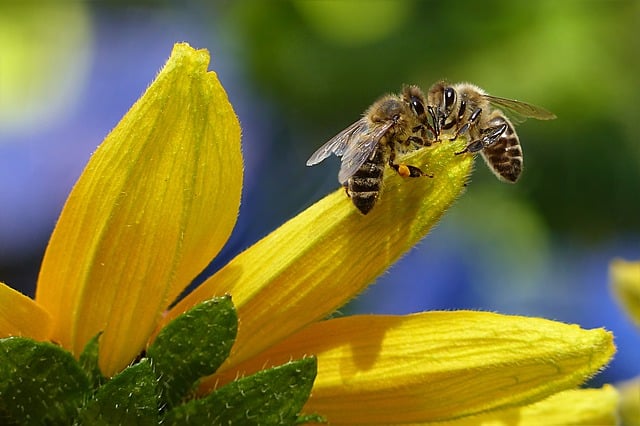
Photo Credit: Pixabay
There are all kinds of ways for eco-conscious homeowners to make sustainable updates to the house and yard. Beekeeping is one of the most rewarding: with the world bee population in serious crisis, starting your own colony can make an important impact in saving these vital insects all while giving the flora of your yard a boost — not to mention providing you a supply of fresh, delicious honey. And it’s probably not nearly as difficult as you think!
This guide will get you on the right track toward your very own backyard bee colony by discussing the benefits of beekeeping, necessary tools and equipment, and offering advice on how to choose and build the right set-up for your yard. Before making the decision to start a colony, ensure that no one in your family has an allergy to bee stings and check with nearby neighbors, as well. You should also investigate local zoning laws, homeowner association guidelines, and any other relevant regulations to your area.
Beekeeping is a rewarding hobby that can truly make an important difference in the world, so once you’ve got the necessary permits, there’s no time to waste!
The Benefits of Backyard Beekeeping
Aside from doing your part to help preserve the world honeybee population, there are many advantages to starting your own colony. Fresh honey is perhaps the most delicious perk! It’s a natural way to sweeten just about any recipe, and once you taste the difference between homegrown honey and store-bought, you’ll likely never go back. Organic honey makes a wonderful gift for family, friends, and neighbors, and you may even opt to sell it, depending on distribution laws in your area.
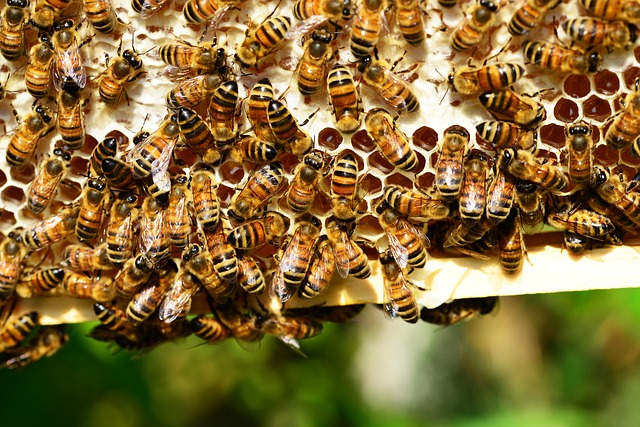
Photo Credit: Pixabay
Beeswax is another natural product of beekeeping, and it comes in handy no matter the household. Some people love to use beeswax to make organic beauty products like lip balms, lotions, and hair gel. Cooks will love using it as grease for baking pans and a protective sealant on grills. It can even be used in the garden as a grafting wax, in the living room as natural furniture polish, or in the garage as rust protection on tools. And of course, homemade beeswax candles are a beautiful accent to any home — plus they make excellent gifts!
Gardeners may perhaps benefit the most from beekeeping; honeybees can help pollinate flower and vegetable gardens and allow them to thrive. This perk can be a selling point when it comes to winning over neighbors who have reservations about your beekeeping efforts, since their own plants will reap the pollination benefits, as well. Even plants that can self-pollinate often see increased pollination when they have help from honeybees.
Tools and Safety Equipment
Naturally, the first item you’ll need for your backyard bee colony is a hive. Most people opt for Langstroth beehives, which have a simple configuration and are typically easy to assemble. Your hive should be placed on some kind of stand to keep it off the ground and safe from water damage and pesky bee predators like skunks. A stand can be as simple as stacked cinderblocks with sturdy wood panels for support — just make sure your hive doesn’t end up too high to access easily! Don’t forget to include an inclined board on the front of the stand; some bees will miscalculate their entry and crash into the wall, but having a ramp can help them make it into the hive safely.
Choosing the right hive, as well as how many you want total, will depend largely on how much space you have to commit to the cause and the time you’ll be able to devote to beekeeping. Consider starting with a single, smaller hive as you learn and work your way up, if desired. An eight-frame (versus the standard ten-frame) hive tends to be lighter and easier to work with while still leaving plenty of room for the bees to produce. Beehives will typically need to be ordered online, or if you’re handy, you can build your own.
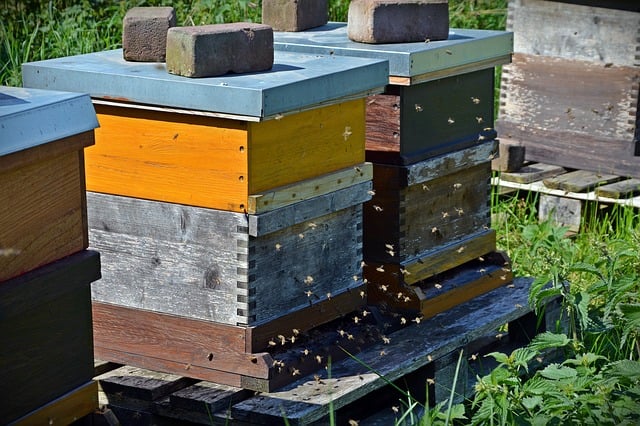
Photo Credit: Pixabay
Next, you’ll want to find the right safety gear. Some items to consider include:
- Full beekeeping suit
- Sun hat with veil
- Protective eyewear, goggles, or sunglasses
- Lightweight beekeeping jacket
- Gloves
- Boots
Though you may eventually feel comfortable enough to only wear a hat, gloves, and veil, it’s helpful to have a full suit if you’re a novice. Not only will it help you ease into feeling comfortable around your hive, it can come in handy for more heavy-duty hive upkeep. Suits can get especially uncomfortable in the hot summer months, so stick with white or other light colors that will reflect the sun.
Though honeybees aren’t inherently aggressive, you should be prepared for them to land on you while you work. It can be unnerving to watch a bee land on your hand or to hear one whizz past your ear, so give yourself time to adjust to the feeling. You might discover you’re more comfortable wearing long gloves that extend up your arm and prevent any bees from flying up your sleeve. Similarly, wearing hiking or other high-rise boots can help protect your ankles from a misguided bee, and pants will protect your legs better than shorts.
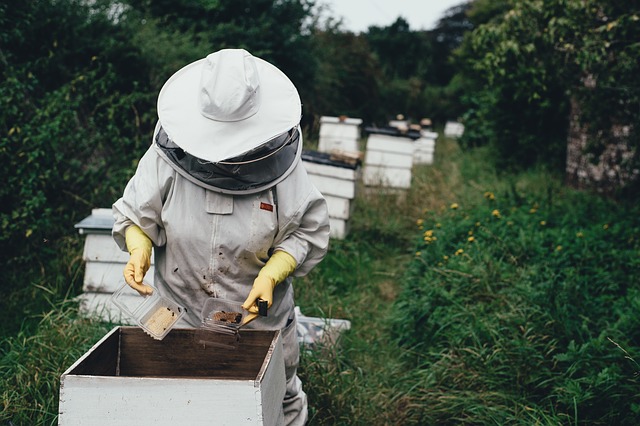
Photo Credit: Pixabay
You’ll also want a beekeeping brush, and a smoker that will distract the bees while you work. Smokers are effective in a couple different ways. First, they interrupt the chemical communication that typically occurs in a beehive. The bees become disoriented and thus more inclined to leave you be while accessing the hive. Second, the smoke triggers an instinctual response: the worker bees believe that their home is at risk of being consumed by a fire, so they head into the hive and consume as much honey as possible, keeping them occupied and out of your way.
Honeybees need regular access to water, especially in rising summer temperatures. Provide some kind of small source of water close to the hive: a small pond, bird bath, pet waterer, or even a dripping faucet will do. Include some kind of raised landing pad that the bees can access, be it a large stone, wood board, stick, or large piece of Styrofoam.
Finally, you’ll need the most important part of any hive: the bees! The American Golden Italian Honeybee tends to be the strongest choice for home-based colonies because they’re generally non-aggressive, excellent honey producers, can withstand colder climates, and have a strong resistance to disease. However, it’s best to check with local beekeepers to see which species are native and tend to thrive in your area. You can typically buy bees directly from these kinds of professionals, but there are many online options, as well. Keep an eye out for when the bees will ship: distributors are often based in warm regions and thus may only send them from early April until June. Shipping bees too early can lead them to freeze and die, and too late can cause them to “cook” within their container before they ever arrive.
Getting Started
When choosing a spot for your beehive, take into consideration the needs and backyard habits of your family. Place it far from where your children play, your pets explore, and houseguests may be during barbecues and other backyard events. It should be somewhere dry and sunny. Some people choose to place their hives close to a wall — around the corner of the house, by the shed, or behind the garage, perhaps — that can help block the wind and will encourage bees to fly up and over rather than at human eye-level. The water source should be somewhere nearby, and bonus points if you can situate the hive close to your flowering plants, as well.
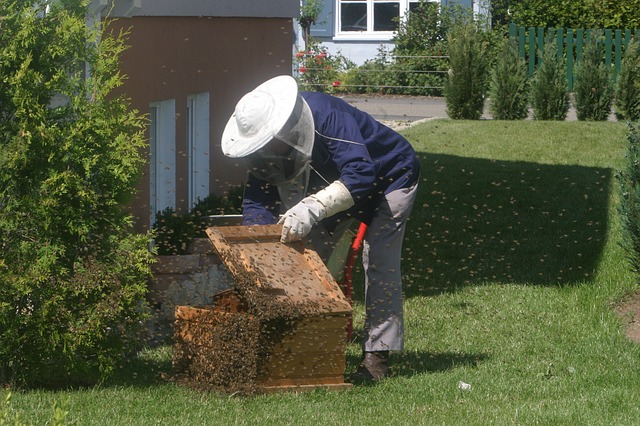
Photo Credit: Pixabay
Make sure that your hive is assembled before your bees arrive so there’s no delay in introducing them to their new home. Follow the instructions of your distributor exactly: these trained professionals will know the best way to help your colony thrive, so take their words as beekeeping gospel. If you feel uncertain about installing the bees on your own, you might be able to find beekeeping classes at a local honey farm that will help you develop your skills. If there aren’t any formal classes and online videos don’t instill the confidence you desire, try reaching out to a local beekeeper to ask for pointers. Most professionals will be happy to answer your questions and will appreciate your desire to get the job done right.
Your bees should be well-fed before installing them into the hive to keep them as calm and gentle as possible. If they didn’t arrive with food from the distributor, you can make some simply by dissolving two parts of sugar in one part water and smearing it across the wire screen of their packaging. Transferring the bees in the late evening can also help reduce issues: with sunlight fading away, the insects are less likely to fly off and get lost.
Exactly how long it takes your hive to produce its first batch of honey will depend on a number of factors, including the area you live in, the size of your colony, and the time of year. In the meantime, find out about local beekeeping groups or communities in your area. They are a great place to meet others who share your passion and an important resource as you hone your new skill. If there aren’t any groups in your immediate area, consider starting one yourself! Even joining an online forum can be beneficial and provide you access to more skilled “beeks” who can offer you tips and insight into the process.
Beekeeping often becomes a passion for those who dare to give it a try, and it’s a wonderful way to make a positive impact on your natural community. Humans will always need bees, and right now, it’s the bees that need us — so pick a spot, build a hive, and help them thrive!
More Resources on Saving the Bees:
- Greenpeace — Save the Bees
- How You Can Help Save The Bees — Even In Winter
- 5 Reasons to Sponsor-A-Hive
- 9 Ways You Can Help Bees and Other Pollinators At Home
- Selecting Plants for Pollinators
- Bee Basics: An Introduction to Our Native Bees
 Raising Chickens at Home
Raising Chickens at Home  Spring Garden Flower Tips and Suggestions
Spring Garden Flower Tips and Suggestions  Plan Ahead for a Better Yard
Plan Ahead for a Better Yard  Xeriscaping: Environmentally Wise Landscaping
Xeriscaping: Environmentally Wise Landscaping  Mature Tree Care and Tree Removal
Mature Tree Care and Tree Removal 

Surprised to see a honey bee article on HomeAdvisor. The article was very well written & covers a lot of the information that a new beekeeper will need to know. Just keep in mind that beekeeping is contagious, one hive & you are hooked for life.